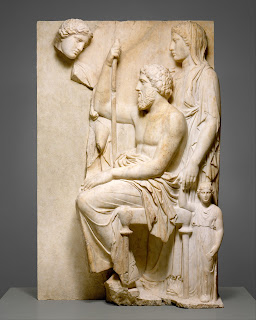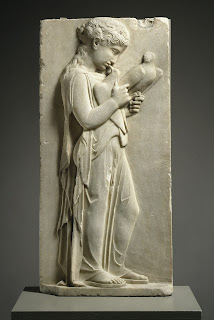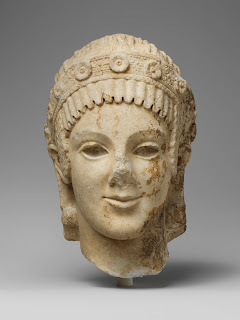"Greek and Roman Marble Art"
My last and final trip for the semester was to the Metropolitan Museum of Art and my assignment was not to just go around looking at "good" and "bad" artwork to write about. But to look for artwork that I would want to place if I ever had an exhibit. The Met had all different type of artwork from all over the world. Artwork that focus on Greek and Roman art, Art from Africa, Oceania & the Americas, to art work from the 19th-20th century European Paintings and Sculptures. My first stop was the Greek and Roman art and I automatically knew what I wanted to focus on for my last and final project. Greek and Rom. an art focus on the culture of status, plates, masks and more culture things. My main interest throughout viewing the Greek and Roman art was the beauty of the marble statuses.
The first piece of marble art work I was "Marble Grave Stele with a Family Group," which is a grave monument of a family that went back from 360 B.C. I thought this was extremely fascinating because it wasn't your typical grave stone that you saw at cemetery. It was so well detailed and I am pretty sure there's a story behind the marble carving of it family. Another piece of marble art work that grasped my attention was another grave monument which is called "Marble Greek Stele of a Little Girl." I thought this was a beautiful piece because it most be for a little Greek girl that passed away, but in the marble carving of the little girl it looks like she is hold a dove, which can symbolize peace. So to me this was a sentimental piece because even though it is most likely a grave monument for a little girl, the little girl is hold a dove which shows that even though she is gone, she is at peace. And the last piece of marble art work that really grabbed my attention when I read the description was the "Marble Statue of a Lion." I really enjoyed reading and looking at this piece because it was a marble lion that they would make to put on a person's grave to keep away the evilness that can come they way. I thought this was interesting because reading it gave me a sense that in the Greek culture even though that person is dead evil can still come and harm them even after they are. So they put the lion on their grave to give them a sense of protection. After viewing all the different marble art works of Greek and Roman times it made me really want to start doing research on their culture and the myths or stories of that continue to live through today.
Culture: Greek, Attic
"Marble Grave Stele with a Family Group"
ca. 360 B.C
Greek and Roman Art
Culture: Roman
"Marble Relief Fragment with Gladiators"
1st-3rd Century A.D
Greek and Roman Art
Culture: Roman
"Marble Head of a Greek General"
1st-2nd Century A.D
Greek and Roman Art
Culture: Roman
"Marble Portrait Head of the Emperor Constantine I"
ca. A.D. 325-370
Greek and Roman Art
Culture: Roman
"Marble Relief with a Dancing Maenad"
ca. 273 B.C.-A.D. 14
Greek and Roman Art
Culture: Greek
"Marble Greek Stele of a Little Girl"
ca. 450-440 B.C.
Greek and Roman Art
Culture: Roman
"Marble Portrait Bust of a Woman"
ca. A.D 193-211
Greek and Roman Art
Culture: Greek, Attic
"Marble Stele (Grave Marker) of a Woman"
Mid-4th Century B.C.
Greek and Roman Art
Culture: Greek
"Marble Statue of a Lion"
ca. 400-390 B.C.
Greek and Roman Art
Culture: Roman
"Marble Head of Zeus Ammon"
ca. 120-160 A.D.
Greek and Roman Art
Culture: Roman
"Marble Head of Athena"
ca. 27 B.C.-A.D. 68
Greek and Roman Art
Culture: Roman
"Marble Statue of a Bearded Hercules"
A.D. 68-98
Greek and Roman Art
Culture: Roman
"Marble Herm"
1st or 2nd Century A.D.
Greek and Roman Art
Culture: Greek
"Marble Head of a Goddess"
4th Century B.C.
Greek and Roman Art
Culture: Greek
"Marble Head of Veiled Goddess"
Late 4th or 3rd Century B.C.
Greek and Roman Art



















